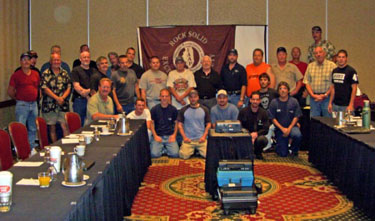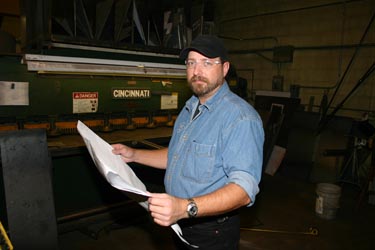 |
Millwrights normally receive training through 4- to 5-year apprenticeship programs that combine on-the-job training with classroom instruction, or through community college programs coupled with informal on-the-job training. These programs include training in dismantling, moving, erecting, and repairing machinery. Trainees also may work with concrete and receive instruction in related skills, such as carpentry, welding, and sheet-metal work. Millwright apprentices attend about one week of  classes every three months. Classroom instruction covers mathematics, blueprint reading, hydraulics, electricity, computers, electronics, and instruction in specific machinery. classes every three months. Classroom instruction covers mathematics, blueprint reading, hydraulics, electricity, computers, electronics, and instruction in specific machinery.
Employers prefer applicants with a high school diploma or equivalency and some vocational training or experience. Courses in science, mathematics, mechanical drawing, computers, and machine shop practice are useful. Millwrights are expected to keep their skills up-to-date and may need additional training on technological advances, such as laser shaft alignment and vibration analysis.
Because millwrights assemble and disassemble complicated machinery, mechanical aptitude is very important. Strength and agility also are necessary for lifting and climbing. Millwrights need good interpersonal and communication skills to work as part of a team and to effectively give detailed instructions to others.
Machinists train in apprenticeship programs, informally on the job, and in vocational schools, or community or technical colleges. Experience with machine tools is helpful. In fact, many entrants previously have worked as machine setters, operators, or tenders. Persons interested in becoming machinists should be mechanically inclined, have good problem-solving abilities, be able to work independently, and be able to do highly accurate work (tolerances may reach 1/10,000th of an inch) that requires concentration and physical effort.
High school or vocational school courses in mathematics (especially trigonometry), blueprint reading, metalworking, and drafting are highly recommended. Apprenticeship programs consist of shop training and related classroom instruction lasting up to 4 years. In shop training, apprentices work almost full time, and are supervised by an experienced machinist while learning to operate various machine tools. Classroom instruction includes math, physics, materials science, blueprint reading, mechanical drawing, and quality and safety practices. In addition, as machine shops have increased their use of computer-controlled equipment, training in the operation and programming of CNC machine tools has become essential. Apprenticeship classes are often taught in cooperation with local community or vocational colleges.  A growing number of machinists learn the trade through 2-year associate degree programs at community or technical colleges. Graduates of these programs still need significant on-the-job experience before they are fully qualified. A growing number of machinists learn the trade through 2-year associate degree programs at community or technical colleges. Graduates of these programs still need significant on-the-job experience before they are fully qualified.
Fabricators learn their trade through both formal and informal training programs. To become a skilled sheet metal worker usually takes between 4 and 5 years. While there are a number of different ways to obtain this training, generally the more formalized the training received by an individual, the more thoroughly skilled become, and the more are likely to be in demand by employers. For some, this training can begin in a high school, where classes in English, algebra, geometry, physics, mechanical drawing and blueprint reading, and general shop are recommended.
After high school, there are a number of different avenues that one can take to obtain the necessary training. One of the ways is to obtain a job with a contractor who will then provide training on the job. Entry-level workers generally start as helpers, assisting more experienced workers. Most begin by carrying metal and cleaning up debris in a metal shop while they learn about materials and tools and their uses. Later, they learn to operate machines that bend or cut metal. Helpers may be promoted to the journey level if they show the requisite knowledge and skills. Most Fabricators in large-scale manufacturing receive on-the-job training, with additional class work or in-house training as necessary.
Usually, apprenticeship applicants must be at least 18 years old and meet local requirements. The length of the program, usually 4 to 5 years, varies with the apprentice’s skill. Apprenticeship programs provide comprehensive instruction in both sheet metal fabrication and assembly.
On the job, apprentices learn the basics of pattern layout and how to cut, bend, fabricate, and install sheet metal. They also use materials such as fiberglass, plastics, and other nonmetallic materials. Apprentices learn drafting, plan and specification reading, trigonometry and geometry applicable to layout work, the use of computerized equipment, and welding. Safety is stressed throughout the program. In addition, apprentices learn the relationship between sheet metal work and other construction work.
Fabricators need to be in good physical condition and have mechanical and mathematical aptitude as well as good reading skills. Some additional skills needed are good eye-hand coordination, spatial and form perception, and manual dexterity also are important. Courses in algebra, trigonometry, geometry, mechanical drawing, and shop provide a helpful background for learning the trade, as does related work experience obtained in the Armed Services.
It is important for experienced Fabricators to keep abreast of new technological developments, such as the use of computerized layout and laser-cutting machines. Workers often take additional training, provided by the union or by their employer, to improve existing skills or to acquire new ones.
Welder training can range from a few weeks of school or on-the-job training for low-skilled positions to several years of combined school and on-the-job training for highly skilled jobs. Formal training is available in high schools, vocational schools, and postsecondary institutions, such as vocational-technical institutes, community colleges, and private welding schools. The Armed Forces operate welding schools as well. While some employers provide basic training, they prefer to hire workers with experience or more formal training. Courses in blueprint reading, shop mathematics, mechanical drawing, physics, chemistry, and metallurgy are helpful. An understanding of electricity also is very helpful and knowledge of computers is gaining importance, especially for welding, soldering, and brazing machine operators, who are becoming more responsible for the programming of computer-controlled machines, including robots.
Some welders become certified, a process whereby the employer sends a worker to an institution, such as an independent testing lab, equipment manufacturer, or technical school, to weld a test specimen according to specific codes and standards required by the employer. Testing procedures are based on the standards and codes set by industry associations with which the employer may be affiliated. If the welding inspector at the examining institution determines that the worker has performed according to the employer’s guidelines, the inspector will then certify that the welder being tested is able to work with a particular welding procedure.
Welding, soldering, and brazing workers need good eyesight, hand-eye coordination, and manual dexterity. They should be able to concentrate on detailed work for long periods and be able to bend, stoop, and work in awkward positions. In addition, welders increasingly need to be willing to receive training and perform tasks in other production jobs.
Submit your resume to:

|
 |